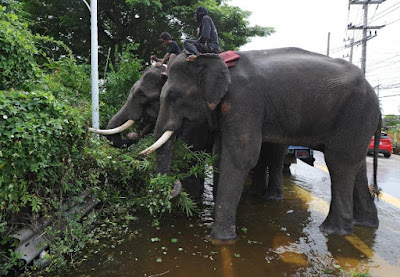Yahoo – AFP,
26 February 2016
 |
More than
140 cats occupy the tiny island of Aoshima in southern Japan (AFP
Photo/Kazuyuki Ono)
|
Tokyo (AFP)
- An army of cats ruling a remote Japanese island are licking their whiskers
after a plea for food aid triggered a flood of donations from across the
country.
More than
140 cats occupy the tiny island of Aoshima in southern Japan -- outnumbering
humans by eight to one -- but when the feral felines recently ran out of cat
food, a cry for help led to an extraordinary response.
"Food
began pouring in from all over Japan," Kazuyuki Ono, 59, whose tweet
raised the alarm, told AFP on Friday.
"There's
so much of it now we can't store it," he added.
"We're
asking people to stop sending donations. But the cats couldn't be
happier."
Fittingly,
hundreds of boxes of cat food arrived at Aoshima dock, a 30-minute boat ride
from the mainland, in time for February 22 -- officially Cat Day in Japan.
"The
food started arriving right at that time," said Ono.
"In
spring and summer, tourists bring food to feed the cats but when it gets cold,
the sea is rough and nobody comes. Sometimes boats can't cross in the rough
seas. It's a mysterious little island."
Aoshima,
known also as Cat Island, was once home to 1,000 people but today only 16
remain, mostly pensioners.
But the
cats, originally brought to the island to kill the mice that infested
fishermen's boats, rule the roost and visitors flock from across Asia and even
Europe to see the fluffy creatures.
"It's
a cat paradise here," said Ono, who took to Twitter at the request of
Naoko Kamimoto, president of the Aoshima Cat Protection Society, after she
found that the cupboard was bare.
"There
are no crows, no dogs, no bikes, no cars," Ono said.
"They
love nothing more than to just lie about in the street sunning themselves all
day. Now their bellies are full, they're purring happily."
 |
Rino
Kakinuma, 7, plays with toy poodles, beagles and a golden retriever
at the Dog
Heart cafe in Tokyo, February 22, 2015 (AFP Photo/Yoshikazu Tsuno)
|
Related Articles:
Dogs by the hour: Japan offers pet rental service
Feline Fun for All at Cutie Cats In Jakarta
Amsterdam to get its own cat cafe, thanks to crowdfunding
Feline Fun for All at Cutie Cats In Jakarta
Amsterdam to get its own cat cafe, thanks to crowdfunding
Question: Dear Kryon: I live in Spain. I am sorry if I will ask you a question you might have already answered, but the translations of your books are very slow and I might not have gathered all information you have already given. I am quite concerned about abandoned animals. It seems that many people buy animals for their children and as soon as they grow, they set them out somewhere. Recently I had the occasion to see a small kitten in the middle of the street. I did not immediately react, since I could have stopped and taken it, without getting out of the car. So, I went on and at the first occasion I could turn, I went back to see if I could take the kitten, but it was to late, somebody had already killed it. This happened some month ago, but I still feel very sorry for that kitten. I just would like to know, what kind of entity are these animals and how does this fit in our world. Are these entities which choose this kind of life, like we do choose our kind of Human life? I see so many abandoned animals and every time I see one, my heart aches... I would like to know more about them.
Answer: Dear one, indeed the answer has been given, but let us give it again so you all understand. Animals are here on earth for three (3) reasons.
(1) The balance of biological life. . . the circle of energy that is needed for you to exist in what you call "nature."
(2) To be harvested. Yes, it's true. Many exist for your sustenance, and this is appropriate. It is a harmony between Human and animal, and always has. Remember the buffalo that willingly came into the indigenous tribes to be sacrificed when called? These are stories that you should examine again. The inappropriateness of today's culture is how these precious creatures are treated. Did you know that if there was an honoring ceremony at their death, they would nourish you better? Did you know that there is ceremony that could benefit all of humanity in this way. Perhaps it's time you saw it.
(3) To be loved and to love. For many cultures, animals serve as surrogate children, loved and taken care of. It gives Humans a chance to show compassion when they need it, and to have unconditional love when they need it. This is extremely important to many, and provides balance and centering for many.
Do animals know all this? At a basic level, they do. Not in the way you "know," but in a cellular awareness they understand that they are here in service to planet earth. If you honor them in all three instances, then balance will be the result. Your feelings about their treatment is important. Temper your reactions with the spiritual logic of their appropriateness and their service to humanity. Honor them in all three cases.
Do animals know all this? At a basic level, they do. Not in the way you "know," but in a cellular awareness they understand that they are here in service to planet earth. If you honor them in all three instances, then balance will be the result. Your feelings about their treatment is important. Temper your reactions with the spiritual logic of their appropriateness and their service to humanity. Honor them in all three cases.








